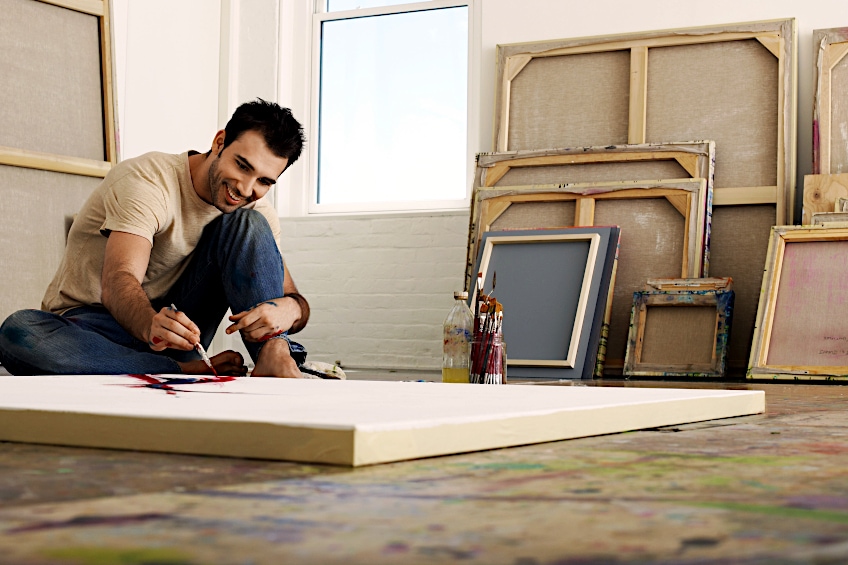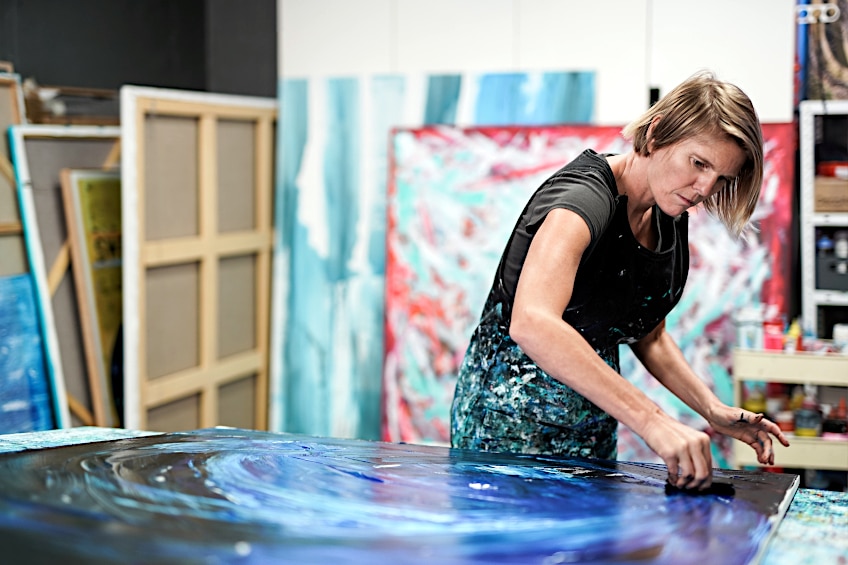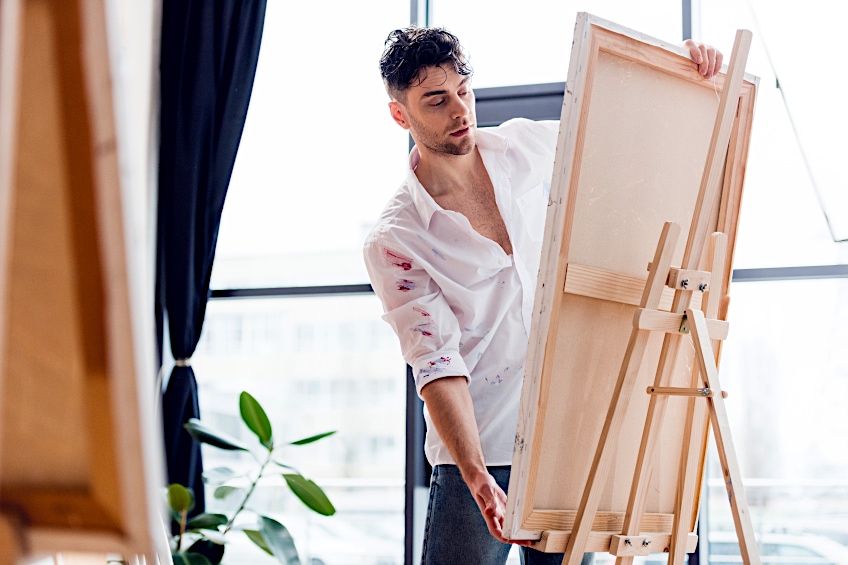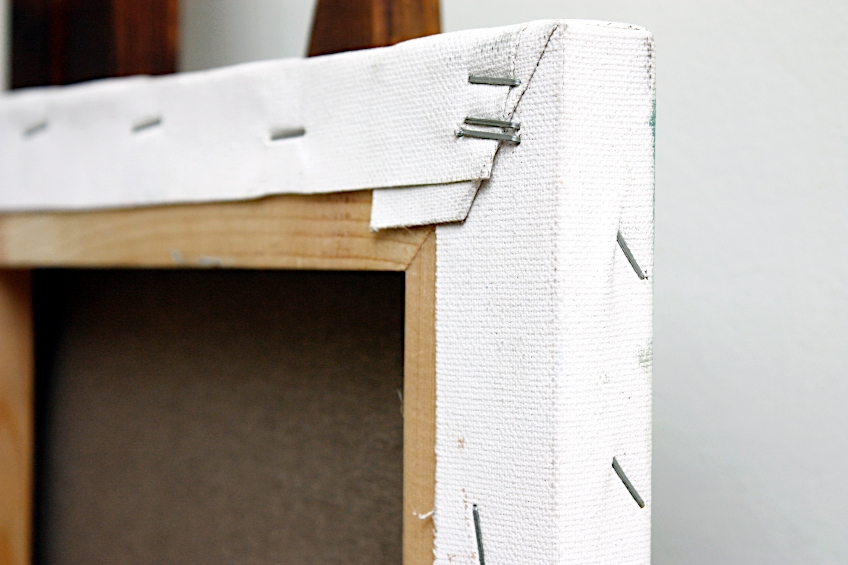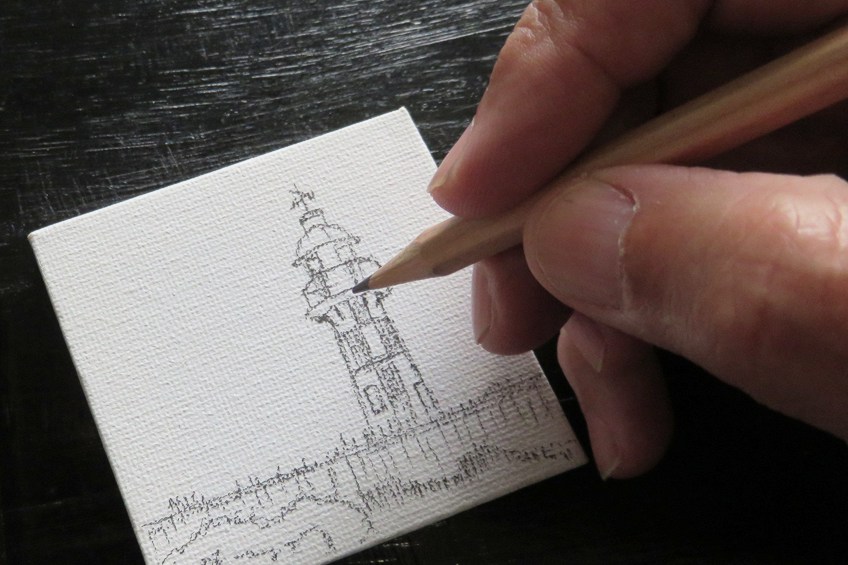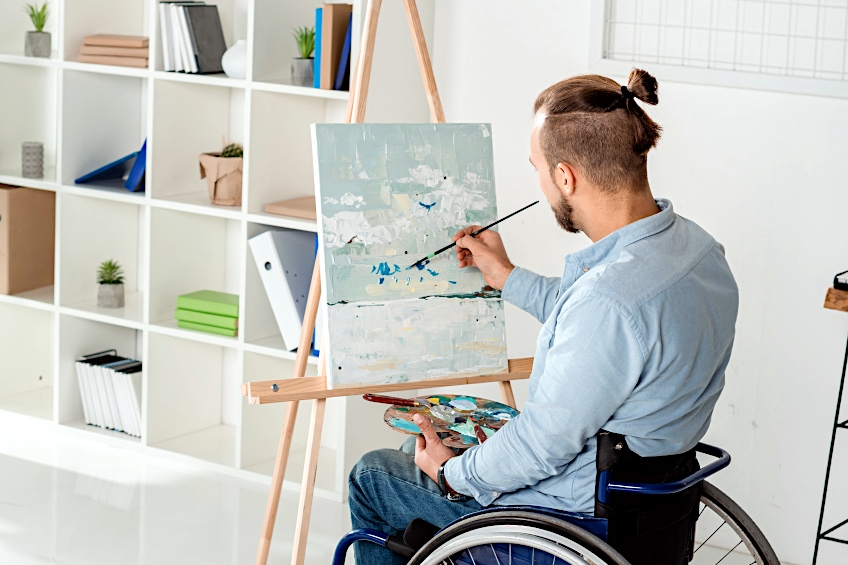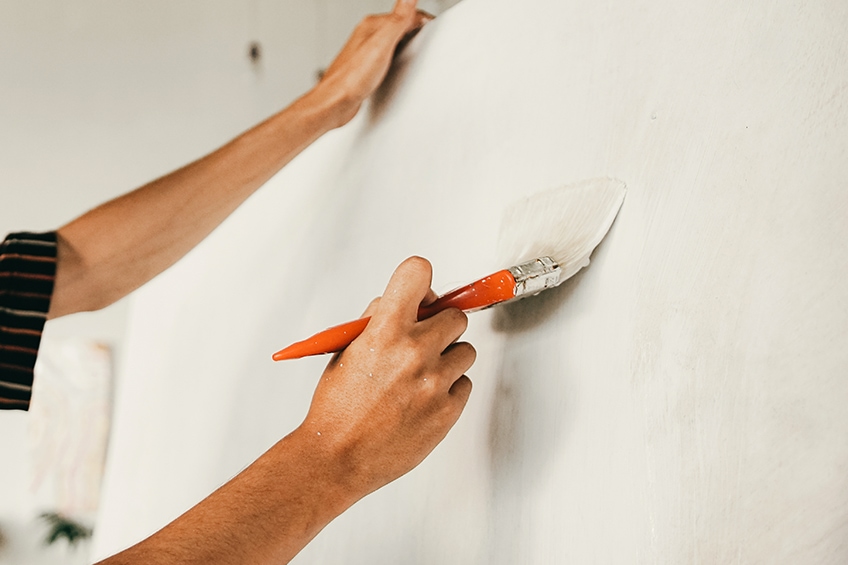Canvas Painting Tips – A Beginner’s Guide to Painting on Canvas
If you are a first-time painter and only just discovering the joys of painting on canvas, it can be a bit intimidating to face off with a blank, white surface. You might have a ton of ideas running through your head, but where do you start? We hope these canvas painting tips and guidelines will help you through the process, so you can focus on simply being creative.
How to Start Canvas Painting
A Canvas surface offers many more benefits when compared to paper. Canvas is more durable, and any painting should last for a very long time. You also get many different sizes of canvas, all of which are easy to use. However, you should consider a few things first when painting on canvas.
Choosing the Right Canvas
Paintings in the past were often done on wooden panels, however, often paintings suffered warping and cracking due to the rigid surface. This is where canvas becomes more popular, as it is lightweight and if prepared properly, will not warp or crack. Canvas is a woven fabric that has been used for many years for things like sails or to make tents. In the art world, it is used as a painting surface and is usually stretched over a wooden frame.
However, you can also stretch your own canvas as well. The two main options you can use include oil paints and paints for acrylic art on canvas.
Popular Canvas Types
Canvas is affordable, sturdy, and when prepared correctly, paintings should last a long time. The technical term for this is archival. You can walk into any art supply store to find an array of canvas options.
Cotton Canvas
This is your most affordable option and is the best choice for beginners. When you prepare a cotton canvas properly, it should last a long time. The canvas is usually flexible and durable, and you can get canvasses that already have an acrylic primer applied.
Since these are cheaper, they are great to experiment on.
Linen Canvas
Linen is even more durable and lasts longer than cotton canvas. However, this option is also more expensive. A linen canvas often comes ready-primed, will not warp over time, offers superior support, and is a better-quality surface to paint on, which makes it a popular choice for many professional painters.
Canvas Board
This is another good choice for beginners and is also a more affordable option. Some are boards that have been primed and stamped to exhibit a canvas-like texture, while others are made from primed cotton canvas that has been stretched over fiberboard. Canvas boards are thinner than normal canvas and are a great choice if you want to do plein air painting. Canvas boards are also more rigid, while other options are more flexible.
This is a matter of preference; some artists prefer to have more flexibility.
Some Alternatives to Canvas
There are also a few alternatives you can use to paint on. Some of these are more expensive like the gesso board. These are made from high-density hardwood and are strong, but lightweight. They come in various thicknesses and offer superior brush control. You can also choose a metal surface, which is non-porous and naturally smooth. This option is also lightweight, and the two best options would be copper and aluminum.
Take note, however, that metal panels also still need to be primed to create a surface to which the paint can bond.
Choosing a Paint Medium
There is more than one type of paint you can use on canvas, the two most popular are oil paints and acrylic paints. Oil paints offer an amazing depth of color and flexibility and can be applied in a variety of ways. The paints can be mixed and layered easier than other options. There are loads of techniques you can incorporate from glazing to impasto.
Oil paints have a long drying time, so artists can work longer on a piece.
Acrylic paints, on the other hand, dry quite quickly, so there is a smaller window of time to work. However, they are quite versatile and can be used from the tube for vibrant color and can be diluted to create more of a watercolor effect. Acrylics are also safer to use as you only need water to clean everything. There are also quite a few acrylic mediums and additives you can use that have various results.
For example, there is a medium that can help to slow the drying time.
Setting Up
Before you even begin painting, you should set up a painting space where you have access to all your art supplies. Do you like to remain seated when painting or do you prefer standing? You will need to decide if you prefer to paint on a flat surface or an easel that provides an upright or angled surface to paint on. Have all brushes, paints, and palette knives close at hand.
Choosing Paintbrushes
Some brushes suit canvas painting better than others. For example, you should not be using watercolor brushes when using oil or acrylic paints, as they are too delicate and will be severely damaged. Acrylic brushes are best suited for painting on canvas as they are more durable. You can purchase individual brushes, or you can also get various brush sets. There are a few different paintbrushes you can have in a collection from flat to fan, round, and round tip brushes.
Remember to always clean brushes once you are done with them.
Applying a Primer
When you learn how to paint on canvas, you usually discover that the canvas needs to be primed, which helps prepare the surface for painting. There are two types of primer, an oil primer, and an acrylic gesso primer. The oil primer is the traditional route that allows oil paint to adhere to it, while the acrylic gesso is a more recent option.
You can use oil paints over acrylic gesso, but it is not a good idea to use acrylic paint over an oil primer as the acrylic paint does not adhere properly to the oiled surface.
Ready-made gesso can be purchased from any art store and is very similar to white acrylic paint, but it has a thinner consistency. The gesso will dry hard and prepares the canvas surface for painting, and without the gesso, the paint would be absorbed by the canvas.
Besides white, you can also now get black and colored gesso. You can also include a little acrylic paint into the gesso to color it any color you want.
Many of the stretched canvas products already come pre-primed, however, many recommend that it is a good idea to add another one or two gesso layers for better tooth and absorbency. When applying the gesso, it is best to use a wide and flat brush. Simply dip the brush into the gesso and apply it to the surface horizontally, making sure an even layer is applied to the entire canvas surface.
You might notice some lines or lumps as brush the gesso on. To remedy this, just take another clean bush and smooth out the gesso. Once done, leave the gesso to dry for 20 minutes to an hour or it could sometimes be more. If you use an oil primer, it can take anything from 24 to 72 hours for it to dry enough to paint on.
Test the gesso by touching the surface, if it lifts, it needs to dry for longer.
Once dry, you can sand the surface lightly using fine-grit sandpaper. This is optional, but it does provide for a super smooth finish. Apply a second layer, this time vertically, and follow the same process as the first layer. Two layers are the general amount to add, but you can add more depending on the effects you want to produce.
Once done with the priming, leave the canvas for at least a day so it can dry thoroughly.
Not only does the gesso provide a surface for the paint to adhere to, but it can make acrylic paint colors appear brighter and provides nice textured layers to work on. The paint also transfers or adheres better to the gesso, which helps protect the brush from being used too harshly. Since the paint does not sink into the canvas with the gesso layer applied, you also save on the paint you are using.
You can also select various types of gessoes. You have student-grade as well as artist-grade gesso options, the latter being more expensive and better for professional artists. Gesso also comes in various containers, from squeeze bottles to spray-on gesso.
Painting on Canvas
How to start canvas painting? Applying gesso is a step in the right direction when painting on canvas. However, if you used white gesso, you still have the daunting blank surface, to begin with. To help things progress more easily, you can apply a ground color. If you have not used a colored gesso, this is simply a base coat of paint. This can help to take the hesitation out of moving forward when painting.
The color you choose can set the tone and mood for the painting and creates a unifying effect from the beginning.
The underpainting helps form a foundation for the rest of the painting and helps develop composition, value relationships, and placement. You also get more depth and dimension to a painting. Some of the more traditional base colors are yellow ochre and burnt sienna, or earth colors as well as gray.
Paint Colors
When using oil paints, they dry to approximately the same color it was applied. When it comes to acrylic art on canvas, the paints are different because they can dry a little darker than when it was applied. When it comes to acrylics, you must learn to adjust the color mixes so that you achieve the proper colors.
Test out your paint blend on a piece of test paper, leave it to dry, and see what the difference is before applying it to the final artwork.
Drying the Painting
You should leave the canvas to dry in a well-ventilated, cool, and dry space. However, it must be a safe place where nobody can touch it and where there is little dust. This is especially important for oil paints that take longer to dry.
Tips for Painting on Canvas
We have been through the brief process of painting on canvas, however, there are a few more canvas painting tips to discover. There is always something new to learn, but it helps if others have gone through the process first. Let us look at some recommended tips for painting on canvas.
Making Use of Canvas Wedges
You may have noticed a little bag with wooden wedges in them when purchasing a canvas. What you should be doing with these is hammering them into the holes on the inside of the canvas in the corners. This creates more tension on the surface of the canvas. You need this tension to be able to control brush strokes better.
If you paint often, you might consider purchasing a small rubber mallet for this purpose.
Consider Using a Mahlstick
Another item you might never hear of is a mahlstick. This special stick that has a padded head is there to help rest your hand when painting. This offers more control, which helps you apply more precise strokes to the canvas surface. The stick also prevents you from smudging areas that are still wet.
Sketch an Image First
Make the painting process easier by sketching your image first. This can be done by using a graphite pencil or charcoal on paper and then using this as your guide or lightly outlining the sketch directly only on the canvas. You can then paint over the outlines with a thin coat of white paint to make the lines lighter and apply a seal so it will not come off as you paint.
You can also apply a rough sketch underpainting or wash that you can follow and offers more control over the final painted image.
Erase Mistakes
You can try to erase any mistakes with water if you are using acrylic paints, white titanium paint, or sandpaper. You can first try to scrape the paint off if it is still wet with a palette knife. You can then use some water or linseed oil to wipe the area carefully. Paint over with the white paint and carry on from there. If the acrylic paint happens to be dry, you can take sandpaper and lightly remove the paint.
Just remember that doing this can affect the texture and tooth of the canvas surface, which can become noticeable once you painted over the area again.
Experiment With Blending Colors
You should learn how to paint on canvas using a color wheel and gain an understanding of color theory to create realistic or harmonious artwork. This can be quite challenging, to begin with, however, you can easily experiment and create your own color palette or swatches. Keep notes as you make blends, so you can refer back to the color you created in the future.
When painting on canvas, and you want to blend colors, rather use a proper mixing palette instead of doing it on the canvas itself. If you make a mistake when blending or mixing on the canvas surface, it can become difficult to remove the paint.
Creating a Consistent Finish With Acrylics on Canvas
Not all brands of acrylic paints dry to the same finish. So, if you want to get a more consistent look, you can use a water-based varnish for the painting. You can get varnishes that come in various finishes from gloss to matte. Not only will it provide a more consistent look, but the varnish also adds another layer of protection from moisture and dirt.
Keeping Acrylic Paints Moist When Painting on Canvas
Acrylic paints tend to have a fast drying time, so you have to move fairly quickly when painting. You can use acrylic mediums or additives to slow down the drying process, but you can also simply use some water in a sprayer. While you are painting, mist the paint with water every few minutes to keep it moist. You need to do this consistently while you are busy as acrylic paints cannot get reactivated once it has dried.
Although, there are brands today that can be rewetted or reactivated after drying.
Learning to paint on canvas can be fun, and not as difficult as you might think. By simply following some guidelines and easy canvas painting tips, you can start creating some amazing art pieces in no time!
Frequently Asked Questions
Can You Use Watercolors on Normal Canvas?
Normal canvas, even if gesso has been applied, is not absorbent enough for watercolor paints. If you want to use watercolors, you can get special watercolor canvasses, which have the look and feel of a canvas but are designed for watercolors.
Can You Paint on Unprimed Canvas?
An unprimed canvas becomes vulnerable to deterioration, mold, and mildew and will not last as long as a primed surface. You will also use a lot more paint and the paint might begin to warp and peel off if the canvas is not primed. So, for best results, priming or applying gesso is an important step.
Should You Paint the Canvas Edges?
Painting canvas edges is optional, however, if you want to create a painting that looks more complete, then this is a detail you do not want to miss. Painted edges also provide a more contemporary feel.
In 2005, Charlene completed her Wellness Diplomas in Therapeutic Aromatherapy and Reflexology from the International School of Reflexology and Meridian Therapy. She worked for a company offering corporate wellness programs for a couple of years, before opening up her own therapy practice. It was in 2015 that a friend, who was a digital marketer, asked her to join her company as a content creator, and this is where she found her excitement for writing.
Since joining the content writing world, she has gained a lot of experience over the years writing on a diverse selection of topics, from beauty, health, wellness, travel, and more. Due to various circumstances, she had to close her therapy practice and is now a full-time freelance writer. Being a creative person, she could not pass up the opportunity to contribute to the Art in Context team, where is was in her element, writing about a variety of art and craft topics. Contributing articles for over three years now, her knowledge in this area has grown, and she has gotten to explore her creativity and improve her research and writing skills.
Charlene Lewis has been working for artincontext.org since the relaunch in 2020. She is an experienced writer and mainly focuses on the topics of color theory, painting and drawing.
Learn more about Charlene Lewis and the Art in Context Team.


